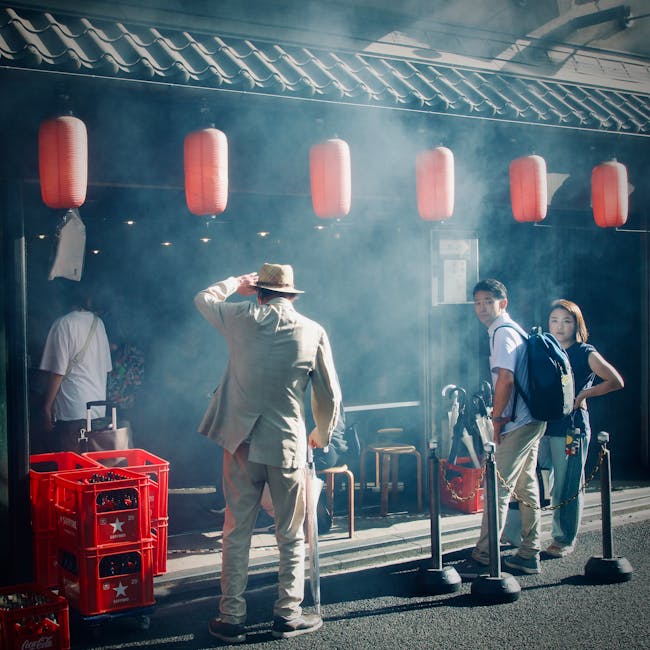Understanding Japanese Etiquette: Navigating Customs with Respect & Grace

Understanding Japanese Etiquette: Navigating Customs with Respect & Grace
Hey there! Ever dreamt of visiting Japan? The land of serene temples, bustling cities, and… intricate etiquette? I know, it can seem a little daunting at first. But trust me, understanding and respecting Japanese customs isn't just about "doing the right thing," it's about enriching your entire travel experience and building genuine connections with the people you meet. Think of it as unlocking a secret level of cultural immersion!
I've been lucky enough to spend a good amount of time in Japan, and while I'm no expert, I've definitely learned a thing or two (and made a few faux pas along the way!). So, let's dive in and explore some essential aspects of Japanese etiquette together. Consider this your friendly guide to navigating the cultural landscape with grace and respect.
The Bow: More Than Just a Greeting

Ah, the bow. It's probably the first thing that comes to mind when you think of Japanese etiquette. And for good reason! The bow, or ojigi, is a fundamental form of greeting, showing respect, and expressing gratitude or apology. It's far more nuanced than a simple head nod, though.
The depth and duration of the bow matter. A slight bow (about 15 degrees) is generally used for casual greetings with friends or colleagues of equal status. A deeper bow (30-45 degrees) is reserved for more formal situations, expressing gratitude to superiors, or offering apologies. The deeper the bow, the greater the respect or sincerity conveyed. Holding the bow for a longer duration also adds weight to its meaning.
Here are a few pointers to keep in mind:
- Posture: Keep your back straight and your eyes downcast. Avoid direct eye contact during a bow, as it can be interpreted as a sign of aggression.
- Reciprocity: Always return a bow with a bow of equal or slightly lesser depth. If someone bows deeply to you, acknowledge their sincerity with a respectful bow in return.
- When to bow: Bow when greeting people, thanking them, apologizing, or even saying goodbye. You'll see people bowing on trains, in shops, and even on the phone!
Don't worry too much about getting it perfectly right. A sincere attempt to bow will always be appreciated. I remember once accidentally bowing a little too enthusiastically to a convenience store clerk. She chuckled, but it was a friendly, understanding chuckle, not a condescending one.
Shoes Off, Relaxation On: Understanding Genkan

Get ready to kick off your shoes! In most Japanese homes, traditional restaurants (especially those with tatami mat seating), and some temples, you'll encounter a genkan – a small entryway where you remove your shoes before stepping onto the main floor. It's a matter of hygiene and respect for the cleanliness of the home.
Here's the drill:
- Remove your shoes before stepping up into the raised floor of the house.
- Turn your shoes to face outwards, making it easier to slip them on when you leave.
- Slippers are provided. Usually, slippers are provided for you to wear inside. Sometimes, there are separate slippers for the toilet – make sure to swap them back when you leave the bathroom!
Wearing shoes inside someone's home is a major faux pas. I almost made this mistake once at a traditional ryokan (Japanese inn) until a kind woman gently stopped me. It's better to err on the side of caution and ask if you're unsure!
Chopstick Charm: Mastering Table Manners

Chopsticks, or hashi, are an integral part of Japanese dining. Using them correctly shows respect for the food and your host. While it might seem intimidating if you're not used to them, a little practice goes a long way.
Here are some key dos and don'ts:
- Do hold your chopsticks about one-third of the way down from the top.
- Do use the chopstick rest (hashi oki) when you're not using your chopsticks.
- Do pick up bowls and bring them closer to your mouth while eating, especially when eating rice or soup.
- Don't stick your chopsticks upright in a bowl of rice. This resembles a funeral ritual and is considered extremely bad luck.
- Don't pass food directly from your chopsticks to someone else's. This also resembles a funeral ritual (passing bones after cremation).
- Don't use your chopsticks to spear food.
- Don't wave your chopsticks around or point with them.
- Don't drag your chopsticks across a plate to gather food.
- Don't hover your chopsticks over several dishes, trying to decide what to eat next.
If you're struggling with chopsticks, don't be afraid to ask for a fork or spoon. Most places are accommodating, especially in tourist areas. I once spent a whole meal chasing a single piece of tofu around my bowl before finally admitting defeat and asking for a fork. The restaurant staff were very understanding and even offered me some chopstick training!
Onsen Etiquette: Relaxing the Japanese Way

Visiting an onsen (hot spring) is a must-do in Japan! It's an incredibly relaxing and culturally significant experience. However, there are some important rules to follow to ensure everyone enjoys themselves.
Here's a quick guide to onsen etiquette:
- Undress completely in the changing room before entering the bathing area. Most onsen have separate bathing areas for men and women.
- Wash thoroughly at the washing stations before entering the hot spring. These stations have small stools, buckets, soap, and shampoo.
- Rinse off all soap before entering the onsen.
- Do not wear a swimsuit in the onsen.
- Do not put your towel in the water. You can place it on your head or the side of the bath.
- Be quiet and respectful. Onsen are meant to be relaxing, so avoid loud conversations.
- Tattoos: Tattoos are often associated with organized crime in Japan, so some onsen may not allow people with tattoos. However, this is becoming less strict, and some onsen provide stickers to cover small tattoos or allow access during certain hours. It's best to check beforehand.
I was definitely nervous the first time I visited an onsen, but the experience was incredible! Just remember to relax, follow the rules, and enjoy the soothing waters.
Gift-Giving: The Art of Presenting

Gift-giving is a significant part of Japanese culture. It's a way of showing appreciation, strengthening relationships, and maintaining harmony. There are specific occasions for gift-giving, such as visiting someone's home, returning from a trip, or during the summer (ochugen) and year-end (oseibo) seasons.
Here are some tips for gift-giving in Japan:
- Presentation matters. Gifts should be beautifully wrapped, preferably in traditional wrapping paper.
- Modesty is key. When giving a gift, offer it with both hands and a humble expression, such as "Tsumaranai mono desu ga" (This is just a small token).
- Don't be surprised if the recipient initially refuses the gift. It's customary to decline a gift once or twice before accepting it with gratitude.
- Don't open the gift immediately. It's polite to wait until the giver has left before opening the gift, unless they specifically ask you to open it.
- Gift suggestions: Popular gifts include food items (like sweets or fruit), local specialties, or practical items like towels or soap. Avoid giving gifts in sets of four, as the word "four" (shi) sounds like the word for "death."
I once brought a bottle of wine as a gift when visiting a Japanese friend's home. I wrapped it as nicely as I could and presented it with a slightly awkward, but sincere, "Tsumaranai mono desu ga." My friend politely declined it once before accepting it with a gracious smile. It was a small gesture, but it went a long way in strengthening our friendship.
Politeness Personified: General Dos and Don'ts

Beyond the specific customs, there are some general principles of politeness that are essential to understanding Japanese etiquette:
- Respect for Elders: Show deference to older people. Offer them your seat on public transport, and be patient and understanding.
- Quietness in Public: Avoid loud conversations on trains and buses. It's considered impolite to disturb others.
- Queuing: Always queue patiently and avoid cutting in line. The Japanese are incredibly orderly and respectful of personal space.
- Mask Wearing: During cold and flu season (and even now post-pandemic), many people wear masks in public to protect themselves and others. It's a considerate gesture to follow suit, especially if you're feeling unwell.
- Bowing on the Phone: You may see people bowing while talking on the phone. This is a habit they developed by showing respect while someone is physically in front of them, even though they are talking to someone on the phone.
I remember being amazed by the quietness on Japanese trains. It was a stark contrast to the noisy commutes I was used to back home. Everyone was either reading, listening to music with headphones, or simply resting quietly. It was a truly peaceful experience.
Lost in Translation? Don't Panic!

Okay, so you might be thinking, "This is a lot to remember!" And you're right, it is. But here's the thing: nobody expects you to be perfect. The Japanese are incredibly forgiving and understanding of foreigners who are trying to learn and respect their culture. Even a small effort to follow local customs will be greatly appreciated.
If you make a mistake (and you probably will!), don't panic. A simple apology, such as "Sumimasen" (I'm sorry), and a sincere smile will go a long way. The most important thing is to be respectful, observant, and open to learning.
I hope this guide has given you a better understanding of Japanese etiquette. Remember, it's not just about following rules, it's about connecting with the culture and showing respect for the people you meet. So, go ahead and plan your trip to Japan with confidence, knowing that you're well-equipped to navigate the cultural landscape with grace and respect. Happy travels!
And hey, if you happen to accidentally wear your shoes into someone's house, don't beat yourself up about it. Just apologize sincerely and learn from the experience. We all make mistakes, but it's the effort that counts!
Post a Comment